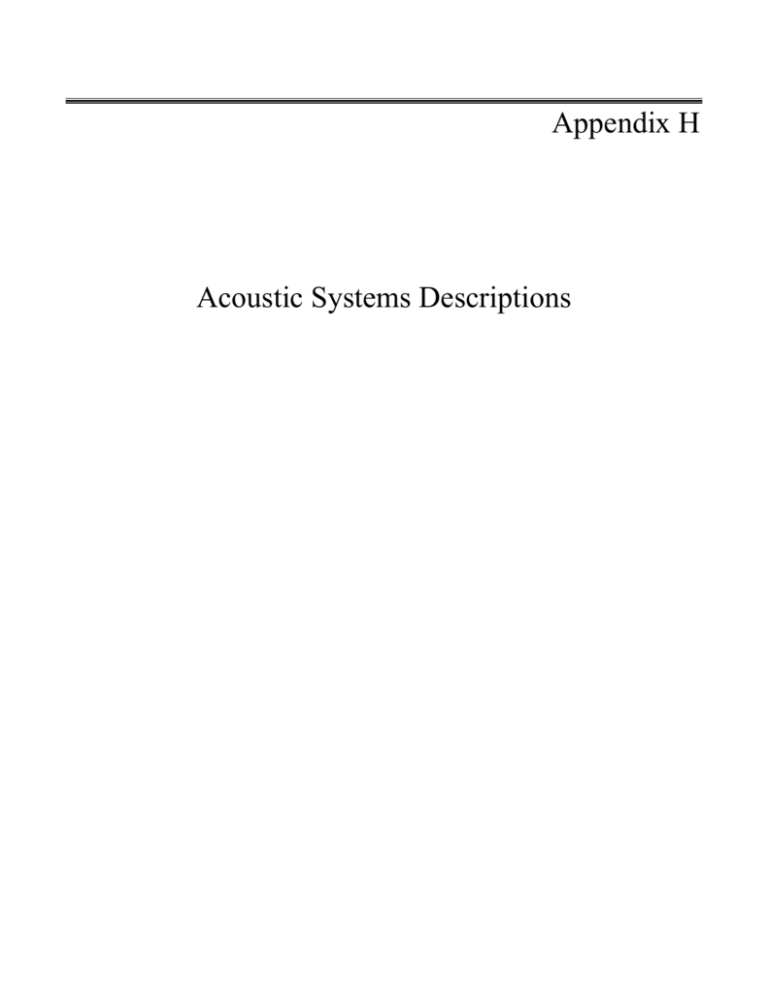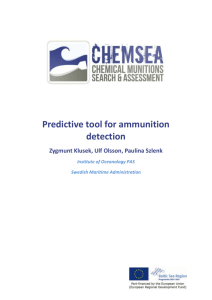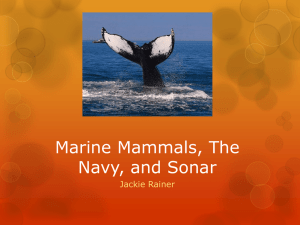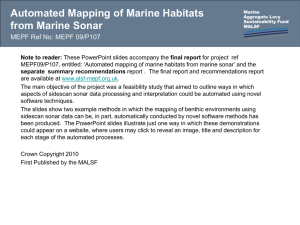Appendix H Acoustic Systems Descriptions
advertisement

Appendix H Acoustic Systems Descriptions GULF OF ALASKA NAVY TRAINING ACTIVITIES EIS/OEIS FINAL (MARCH 2011) T ABLE OF C ONTENTS H ACOUSTIC SYSTEMS DESCRIPTIONS ....................................................................................H-1 H.1 GENERAL SUMMARY OF ACOUSTIC SYSTEMS .............................................................................H-1 H.1.1 SURFACE SHIP SONARS ................................................................................................................ H-1 H.1.2 SURFACE SHIP FATHOMETER ....................................................................................................... H-2 H.1.3 SUBMARINE SONARS .................................................................................................................... H-3 H.1.4 SUBMARINE AUXILIARY SONAR SYSTEMS ................................................................................... H-4 H.1.5 AIRCRAFT SONAR SYSTEMS ......................................................................................................... H-4 H.1.6 TORPEDOES................................................................................................................................... H-7 H.1.7 EXERCISE TRAINING TARGETS ..................................................................................................... H-7 H.1.8 TRACKING PINGERS, TRANSPONDERS, AND ACOUSTICAL COMMUNICATIONS (ACOMS) .......... H-8 H.1.9 PORTABLE UNDERSEA TRAINING RANGE (PUTR) ....................................................................... H-8 H.1.10 ADVANCED EXTENDED ECHO RANGING (AEER) ...................................................................... H-9 L IST OF F IGURES FIGURE H-1. ARLEIGH BURKE CLASS DDG EQUIPPED WITH AN/SQS-53 (L); TICONDEROGA CLASS CG SHOWING AN/SQS-53 (R) ................................................................................................................................................ H-1 FIGURE H-2. OLIVER HAZARD PERRY CLASS FFG EQUIPPED WITH AN/SQS-56 ...................................................... H-2 FIGURE H-3. AN/SQR-19 ......................................................................................................................................... H-2 FIGURE H-4. AN/BQQ-5 ........................................................................................................................................... H-3 FIGURE H-5. SAILORS OPERATING AN/BQQ-10........................................................................................................ H-3 FIGURE H-6. AN/BQS-15 DISPLAY (L), AND SENSOR COMPONENTS (R) ................................................................... H-4 FIGURE H-7. AN/WQC-2 TRANSDUCER (L), AND CONTROL UNIT (R) ....................................................................... H-4 FIGURE H-8. AN/AQS-13 BEING DEPLOYED BY A NAVY HELICOPTER ...................................................................... H-5 FIGURE H-9. AN/AQS-22 BEING DEPLOYED BY A NAVY HELICOPTER ...................................................................... H-5 FIGURE H-10. AN/SQS-62 (L); MPA EQUIPPED WITH AN/SQS-62 SONOBUOYS (R) ................................................ H-6 FIGURE H-11. MPA DEPLOYING AN/SSQ-110A ....................................................................................................... H-6 FIGURE H-12. AN/SSQ-53 (L); AN/SSQ-53 BEING LOADED ONTO MPA (R) ........................................................... H-7 FIGURE H-13. MK 48/MK 48 ADCAP (L); SEAWOLF CLASS SSN LAUNCHING MK-48/MK-48 ADCAP (R) .......... H-7 FIGURE H-14. MK 39 EMATT (L) AND MK 30 (R) .................................................................................................. H-8 FIGURE H-15. MK 84 ................................................................................................................................................ H-8 FIGURE H-16. PORTABLE UNDERSEA TRAINING RANGE DEEP (PUTR-D) TRANSPONDER CONFIGURATION ............ H-9 L IST OF T ABLES TABLE H-1: ECHO RANGING SYSTEMS ...................................................................................................................... H-9 APPENDIX H ACOUSTIC SYSTEMS DESCRIPTIONS i GULF OF ALASKA NAVY TRAINING ACTIVITIES EIS/OEIS FINAL (MARCH 2011) This page intentionally left blank APPENDIX H ACOUSTIC SYSTEMS DESCRIPTIONS ii GULF OF ALASKA NAVY TRAINING ACTIVITIES EIS/OEIS FINAL (MARCH 2011) H ACOUS TIC S YS TEMS DES CRIP TIONS H.1 G ENERAL S UMMARY OF ACOUS TIC S YS TEMS Various active acoustic sources that may or may not affect the local marine mammal population are deployed by platforms during various training activities, exercises and maintenance events. The following sections discuss the acoustic sources that could be present during such training activities, exercises, and maintenance events. H.1.1 Surface Ship Sonars • AN/SQS-53 – a computer-controlled, hull-mounted surface-ship sonar that has both active and passive operating capabilities, providing precise information for anti-submarine warfare (ASW) weapons control and guidance. The system is designed to perform direct-path ASW search, detection, localization, and tracking from a hull-mounted transducer array. The AN/SQS-53 (Figure H-1) is characterized as a mid-frequency active (MFA) sonar, operating from 1 to 10 kilohertz (kHz); however, the exact frequency is classified. The AN/SQS-53 sonar is the major component to the AN/SQQ-89 sonar suite, and it is installed on Arleigh Burke Class guided missile destroyers (DDGs), and Ticonderoga Class guided missile cruisers (CGs). Fig u re H-1. Arle ig h Bu rke Cla s s DDG e q u ip p e d with AN/S QS -53 (L); Tic o n d e ro g a Cla s s CG s h o win g AN/S QS -53 (R) • AN/SQS-53 Kingfisher – a modification to the AN/SQS-53 sonar system that provides the surface ship with an object detection capability. The system uses MFA sonar, although the exact frequency range is classified. This sonar system is installed on Arleigh Burke Class DDGs, and Ticonderoga Class CGs. • AN/SQS-56 – a hull-mounted sonar that features digital implementation, system control by a built-in mini computer, and an advanced display system. The sonar is an active/passive, preformed beam, digital sonar providing panoramic active echo ranging and passive digital multibeam steering (DIMUS) surveillance. The sonar system is characterized as MFA sonar, although the exact frequency range is classified. The AN/SQS-56 (Figure H-2) is the major component of the AN/SQQ-89 sonar suite and is installed on Oliver Hazard Perry Class frigates (FFGs). APPENDIX H ACOUSTIC SYSTEMS DESCRIPTIONS H-1 GULF OF ALASKA NAVY TRAINING ACTIVITIES EIS/OEIS FINAL (MARCH 2011) Fig u re H-2. Olive r Ha za rd P e rry Cla s s FFG e q u ip p e d with AN/S QS -56 • AN/SQR-19 – a tactical towed array sonar (TACTAS) that is able to passively detect adversary submarines at a very long range. The AN/SQR-19, which is a component of the AN/SQQ-89 sonar suite, is a series of passive hydrophones towed from a cable several thousand feet behind the ship. This sonar system is a passive sensing device; therefore, it is not analyzed in this Environmental Impact Statement (EIS)/Overseas Environmental Impact Statement (OEIS). The AN/SQR-19 (Figure H-3) can be deployed by Arleigh Burke Class DDGs, Ticonderoga Class CGs, and Oliver Hazard Perry Class FFGs. Fig u re H-3. AN/S QR-19 H.1.2 Surface Ship Fathometer The surface ship fathometer (AN/UQN-4) is used to measure the depth of water from the ship’s keel to the ocean floor for safe operational navigation. Fathometers are operated from all classes of United States (U.S.) Navy surface ships and are considered MFA sonar, although the exact frequency range is classified. APPENDIX H ACOUSTIC SYSTEMS DESCRIPTIONS H-2 GULF OF ALASKA NAVY TRAINING ACTIVITIES EIS/OEIS FINAL (MARCH 2011) H.1.3 Submarine Sonars • AN/BQQ-5 – a bow- and hull-mounted passive and active search and attack sonar system. The system includes the TB-16 and TB-23 or TB-29 towed arrays and Combat Control System (CCS) MK 2. This sonar system is characterized as MFA, although the exact frequency range is classified. The AN/BQQ-5 (Figure H-4) sonar system is installed on Los Angeles Class nuclear attack submarines (SSNs) and Ohio Class ballistic missile nuclear submarines (SSBNs), although the AN/BQQ-5 systems installed on Ohio Class SSBNs do not have an active sonar capability. The AN/BQQ-5 system is being phased out on all submarines in favor of the AN/BQQ-10 sonar. The operating parameters of both systems with regard to sound output in the ocean are almost identical. For these reasons, these systems will be referred to as AN/BQQ-10 in this EIS. Fig u re H-4. AN/BQQ-5 • AN/BQQ-10 (also known as Advanced Rapid Commercial-Off-the-Shelf Insertion [ARCI]) – a four-phase program for transforming existing submarine sonar systems (i.e., AN/BQQ-5) from legacy systems to more capable and flexible active and passive systems with enhanced processing using commercial-off-the-shelf (COTS) components. The system is characterized as MFA, although the exact frequency range is classified. The AN/BQQ-10 (Figure H-5) is installed on Seawolf Class SSNs, Virginia Class SSNs, Los Angeles Class SSNs, and Ohio Class SSBN/nuclear guided missile submarines (SSGNs). The BQQ-10 systems installed on Ohio Class SSBNs do not have an active sonar capability. Fig u re H-5. S a ilo rs o p e ra tin g AN/BQQ-10 APPENDIX H ACOUSTIC SYSTEMS DESCRIPTIONS H-3 GULF OF ALASKA NAVY TRAINING ACTIVITIES EIS/OEIS FINAL (MARCH 2011) H.1.4 Submarine Auxiliary Sonar Systems • AN/BQS-15 – an under-ice navigation and mine-hunting sonar (Figure H-6) that uses both mid- and high-frequency (i.e., greater than 10 kHz) active sonar, although the exact frequencies are classified. Later versions of the AN/BQS-15 are also referred to as Submarine Active Detection Sonar (SADS). The Advanced Mine Detection System (AMDS) is being phased in on all ships and will eventually replace the AN/BQS-15 and SADS. These systems are installed on Seawolf Class SSNs, Virginia Class SSNs, Los Angeles Class SSNs, and Ohio Class SSGNs. Fig u re H-6. AN/BQS -15 d is p la y (L), a n d s e n s o r c o m p o n e n ts (R) • AN/WQC-25 – an MFA sonar underwater communications system that can transmit either voice or signal data in two bands, 1.5 to 3.1 kHz or 8.3 to 11.1 kHz. The AN/WQC-2 (Figure H-7), also referred to as the “underwater telephone” (UWT), is on all submarines and most surface ships, and allows voice and tonal communications between ships and submarines. Fig u re H-7. AN/WQC-2 tra n s d u c e r (L), a n d c o n tro l u n it (R) H.1.5 Aircraft Sonar Systems Aircraft sonar systems that could be deployed during active sonar events include sonobuoys (tonal [active], listening [passive], and extended echo ranging [EER] or improved extended echo ranging [IEER]) and dipping sonar (AN/AQS-13/22 or AN/AOS-22). Sonobuoys may be deployed by Marine Patrol Aircraft (MPA) or MH-60R helicopters. A sonobuoy is an expendable device used by aircraft for the detection of underwater acoustic energy and for conducting vertical water column temperature measurements. Most sonobuoys are passive, but some can generate active acoustic signals as well as listen passively. Dipping sonars are used by MH-60R helicopters. Dipping sonar is an active or passive APPENDIX H ACOUSTIC SYSTEMS DESCRIPTIONS H-4 GULF OF ALASKA NAVY TRAINING ACTIVITIES EIS/OEIS FINAL (MARCH 2011) sonar device lowered on cable by helicopters to detect or maintain contact with underwater targets. A description of various types of sonobuoys and dipping sonar is provided below. • AN/AQS-13 Helicopter Dipping Sonar – an active scanning sonar that detects and maintains contact with underwater targets through a transducer lowered into the water from a hovering helicopter. It operates at mid-frequency, although the exact frequency is classified. The AN/AQS-13 (Figure H-8) is operated by MH-60R helicopters. Fig u re H-8. AN/AQS -13 b e in g d e p lo ye d b y a Na vy h e lic o p te r • AN/AQS-22 Airborne Low-Frequency Sonar (ALFS) – the U.S. Navy’s dipping sonar system for the MH-60R helicopter Light Airborne Multi-Purpose System III (LAMPS III), which is deployed from aircraft carriers, cruisers, destroyers, and frigates. It operates at midfrequency, although the exact frequency is classified. The AN/AQS-22 (Figure H-9) employs both deep- and shallow-water capabilities. Fig u re H-9. AN/AQS -22 b e in g d e p lo ye d b y a Na vy h e lic o p te r • AN/SSQ-62C Directional Command Activated Sonobuoy System (DICASS) – sonobuoy that operates under direct command from ASW fixed-wing aircraft or MH-60R helicopters (Figure H-10). The system can determine the range and bearing of the target relative to the sonobuoys position and can deploy to various depths within the water column. The active sonar operates at mid-frequency, although the exact frequency range is classified. After water entry, the sonobuoy transmits sonar pulses (continuous waveform [CW] or linear frequency modulation [LFM]) upon command from the aircraft. The echoes from the active sonar signal are processed in the buoy and transmitted to the receiving station onboard the launching aircraft. APPENDIX H ACOUSTIC SYSTEMS DESCRIPTIONS H-5 GULF OF ALASKA NAVY TRAINING ACTIVITIES EIS/OEIS FINAL (MARCH 2011) Fig u re H-10. AN/S QS -62 (L); MP A e q u ip p e d with AN/S QS -62 s o n o b u o ys (R) • AN/SSQ-110A Explosive Source Sonobuoy – a commandable, air-dropped, high source level explosive sonobuoy. The AN/SSQ-110A explosive source sonobuoy (Figure H-11) is composed of two sections, an active (explosive) section and a passive section. The upper section is called the “control buoy” and is similar to the upper electronics package of the AN/SSQ-62 DICASS sonobuoy. The lower section consists of two signal underwater sound (SUS) explosive payloads of Class A explosive weighing 1.9 kg (4.2 lbs) each. The arming and firing mechanism is hydrostatically armed and detonated. Once in the water, the SUS charges explode, creating a loud acoustic signal. The echoes from the explosive charge are then analyzed on the aircraft to determine a submarine’s position. The AN/SSQ-110A explosive source sonobuoy is deployed by MPA. Fig u re H-11. MP A d e p lo yin g AN/S S Q-110A • AN/SSQ-53D/E Directional Frequency Analysis and Recording (DIFAR) – a passive sonobuoy deployed by MPA aircraft and MH-60R helicopters. The DIFAR sonobuoy (Figure H-12) provides acoustic signature data and bearing of the target of interest to the monitoring unit(s) and can be used for search, detection, and classification. The buoy uses a hydrophone with directional detection capabilities in the very low frequency, low frequency, and midfrequency ranges, as well as an omnidirectional hydrophone for general listening purposes. APPENDIX H ACOUSTIC SYSTEMS DESCRIPTIONS H-6 GULF OF ALASKA NAVY TRAINING ACTIVITIES EIS/OEIS FINAL (MARCH 2011) Fig u re H-12. AN/S S Q-53 (L); AN/S S Q-53 b e in g lo a d e d o n to MP A (R) H.1.6 Torpedoes Torpedoes are the primary ASW weapon used by surface ships, aircraft, and submarines. When torpedoes operate actively, they transmit an active acoustic signal to ensonify the target and use the received echoes for guidance. • MK 48 and MK 48 Advanced Capability (ADCAP) (Figure H-13) are heavyweight torpedoes deployed on all classes of Navy submarines. MK 48 and MK 48 ADCAP torpedoes are inert and considered HF sonar, but the frequency ranges are classified. Due to the fact that both torpedoes are essentially identical in terms of environmental interaction, they will be referred to collectively as the MK48 in this EIS. Fig u re H-13. MK 48/MK 48 ADCAP (L); S e a wo lf Cla s s S S N la u n c h in g MK-48/MK-48 ADCAP (R) H.1.7 Exercise Training Targets There are two types of training targets, the MK 30 Acoustic Target and the MK 39 Expendable Mobile ASW Training Target (EMATT) (Figure H-14). ASW training targets simulate submarines as an ASW target in the absence of participation by a submarine in an exercise. They are equipped with acoustic projectors emanating sounds to simulate submarine acoustic signatures, and echo repeaters to simulate the characteristics of the reflection of a sonar signal from a submarine. APPENDIX H ACOUSTIC SYSTEMS DESCRIPTIONS H-7 GULF OF ALASKA NAVY TRAINING ACTIVITIES EIS/OEIS FINAL (MARCH 2011) Fig u re H-14. MK 39 EMATT (L) a n d MK 30 (R) In addition, surface targets such as “sleds” (aluminum catamarans), seaborne powered targets (radiocontrolled high-speed boats), and target drone units (TDUs) could also be deployed during training exercises. H.1.8 Tracking Pingers, Transponders, and Acoustical Communications (ACOMs) Tracking pingers are installed on training platforms to track the position of underwater vehicles. The pingers generate a precise, preset, acoustic signal for each target to be tracked. ACOMs and transponders provide the communication link between sensor packages and base platform allowing information to be exchanged. • MK 84 Pinger Signal, Underwater Sound (SUS) – an air or surface dropped noisemaking device (Figure H-15) that emits one of five mid-frequency tonal patterns using two MFA sonars with frequencies at 3.1 and 3.5 kHz; it is used to provide prearranged signal communications to submerged submarines. Fig u re H-15. MK 84 H.1.9 Portable Undersea Training Range (PUTR) The Portable Undersea Training Range (PUTR) is a self-contained, portable, undersea tracking capability that employs modern technologies to support coordinated USW training for Forward Deployed Naval Forces (FDNF). PUTR will be available in two variants to support both shallow and deep water remote operations in keeping with Navy requirements to exercise and evaluate weapons systems and crews in the environments that replicate the potential combat area. PUTR-D, shown below in Figure H-16, consists of a set of transponders which will be deployed by a ship of opportunity and anchored to the ocean bottom. Once deployed a survey is conducted by a range vessel to determine the transponder locations and to test tracking accuracy. The transponder is activated by utilizing an acoustic command signal during operations and commanded into sleep mode when not in use. Operational lifetime, due to transponder battery life, will meet the key performance parameters, including the operating objective of actual tracking time. The transponders can remain deployed for up to 12 months in a dormant state. Transponders will be recovered for battery/buoy maintenance or for range recovery by transmitting an acoustic command which releases the transponder electronics/floatation buoy APPENDIX H ACOUSTIC SYSTEMS DESCRIPTIONS H-8 GULF OF ALASKA NAVY TRAINING ACTIVITIES EIS/OEIS FINAL (MARCH 2011) package from the anchor. The ship of opportunity will then retrieve the transponders leaving the anchor in-situ. Fig u re H-16. P o rta b le Un d e rs e a Tra in in g Ra n g e De e p (P UTR-D) Tra n s p o n d e r Co n fig u ra tio n H.1.10 Advanced Extended Echo Ranging (AEER) The Advance Extended Echo Ranging program examines improvements in both long-range shallow and deep water ASW search using active sources (Air Deployable Low Frequency Projector (ADLFP), Advance Ranging Source (ARS)) and passive sonobuoy receivers (Air Deployable Active Radar Receiver (ADAR)). The signal processing is provided by research conducted under Advanced Multi-static Processing Program (AMSP). The AEER system is similar to the IEER system in that it uses the AN/SSQ-101 Air Deployed Active Receiver (ADAR) sonobuoy. But instead of the SSQ-110A Extended Echo Range Sonobuoy it is coupled with the SSQ-125 Air Deployable Coherent Source Sonobuoy. The SSQ-125 system is in the R&D stage with two types of sensor technology being considered (the ADLFP and ARS). The buoy is intended to provide the user with a sonobuoy with an improved bi-static acoustic source and better signal processing for harsh water environments. Table H-1 below is a comparison of the echo ranging systems. Ta b le H-1. Ec h o Ra n g in g S ys te m s Current System Current System Future System Aircraft System = EER IEER AEER Buoys = (Source) SSQ-110 (EER) SSQ-110 (EER) SSQ-125 (ADLFP) Buoys = (Receiver) SSQ-77 (VLAD) SSQ-101 (ADAR) SSQ-101 (ADAR) Area of use = Deep Water Only Littoral &Deep Water Enhanced Littoral & Deep Water Used by P-3C P-3C (IOC) P-3C/MH-60R APPENDIX H ACOUSTIC SYSTEMS DESCRIPTIONS H-9 GULF OF ALASKA NAVY TRAINING ACTIVITIES EIS/OEIS FINAL (MARCH 2011) This page intentionally left blank. APPENDIX H ACOUSTIC SYSTEMS DESCRIPTIONS H-10




